Study of Regional Spatial and Temporal Changes of Net Ecosystem Productivity of Crops from Remotely Sensed Data
Abstract
1. Introduction
2. Study Area and Data
2.1. Study Area
2.2. Data Sources and Processing
2.2.1. Land Cover Data
2.2.2. MODIS NPP Product (MOD17A3H v006)
2.2.3. NDVI
2.2.4. Meteorological Data
3. Methods
3.1. Estimation of NPP Based on an Improved CASA Model
3.1.1. Determination of Absorbed Photosynthetically Active Radiation
3.1.2. Estimation of FPAR
3.1.3. Estimation of Actual Light Energy Utilization
3.2. Calculation of NEP Based on the Soil Respiration Equation
3.3. Theil–Sen Median Slope Estimation and Mann–Kendall Trend Analysis
3.4. Partial Correlations Analysis
4. Results
4.1. Reliability Analysis of NPP Estimation Results
4.2. Spatial Distribution of NEP
4.3. Temporal Changes in NEP
4.4. Analysis of Trends
4.5. Partial Correlation Analysis between NEP and Meteorological Factors
5. Discussions
5.1. Performance Evaluation
5.2. Spatiotemporal Pattern of the NEP
5.3. Response of NEP to Climate Factors
5.4. Summary and Prospects of the Study
6. Conclusions
Author Contributions
Funding
Data Availability Statement
Conflicts of Interest
References
- Symonds, M.E. Faculty Opinions recommendation of IPCC, 2021: Summary for Policymakers. In Climate Change 2021: The Physical Science Basis. Contribution of Working Group I to the Sixth Assessment Report of the Intergovernmental Panel on Climate Change; Faculty Opinions—Post-Publication Peer Review of the Biomedical Literature; Cambridge University Press: Cambridge, UK, 2021. [Google Scholar]
- Kumar, P.; Martino, D.; Smith, P.; Al, E. Agriculture (Chapter 8) in IPCC, 2007: Climate Change 2007: Mitigation of Climate Change. In Contribution of Working Group III to the Fourth Assessment Report of the Intergovernmental Panel on Climate Change; Cambridge University Press: Cambridge, UK, 2007; pp. 497–540. [Google Scholar]
- Dachraoui, M.; Sombrero, A. Effect of tillage systems and different rates of nitrogen fertilisation on the carbon footprint of irrigated maize in a semiarid area of Castile and Leon, Spain. Soil Tillage Res. 2020, 196, 104472. [Google Scholar] [CrossRef]
- Liu, X.C.; Wang, S.; Zhuang, Q.L.; Jin, X.X.; Bian, Z.X.; Zhou, M.Y.; Meng, Z.; Han, C.L.; Guo, X.Y.; Jin, W.J.; et al. A Review on Carbon Source and Sink in Arable Land Ecosystems. Land 2022, 11, 580. [Google Scholar] [CrossRef]
- Zhao, M.Y.; Liu, Y.X.; Zhang, X.Y. A review of research advances on carbon sinks in farmland ecosystems. Acta Ecol. Sin. 2022, 42, 9405–9416. [Google Scholar]
- Lal, R. Soil carbon dynamics in cropland and rangeland. Environ. Pollut. 2002, 116, 353–362. [Google Scholar] [CrossRef]
- Fang, J.Y.; Ke, J.H.; Tang, Z.Y.; Chen, A.P. The concept, estimation and interrelationship of the “4Ps” of biological productivity. J. Plant Ecol. 2001, 25, 414–419. [Google Scholar]
- Huang, Y.T.; Wang, F.; Zhang, L.J.; Zhao, J.F.; Zheng, H.; Zhang, F.; Wang, N.; Gu, J.K.; Zhao, Y.F.; Zhang, W.S. Changes and net ecosystem productivity of terrestrial ecosystems and their influencing factors in China from 2000 to 2019. Front. Plant Sci. 2023, 14, 1120064. [Google Scholar] [CrossRef] [PubMed]
- Liang, L.; Geng, D.; Yan, J.; Qiu, S.Y.; Shi, Y.Y.; Wang, S.G.; Wang, L.J.; Zhang, L.P.; Kang, J.R. Remote Sensing Estimation and Spatiotemporal Pattern Analysis of Terrestrial Net Ecosystem Productivity in China. Remote. Sens. 2022, 14, 1902. [Google Scholar] [CrossRef]
- Pathak, K.; Malhi, Y.S.; Sileshi, G.; Das, A.K.; Nath, A.J. Net ecosystem productivity and carbon dynamics of the traditionally managed Imperata grasslands of North East India. Sci. Total Environ. 2018, 635, 1124–1131. [Google Scholar] [CrossRef]
- Ceschia, E.; Béziat, P.; Dejoux, J.-F.; Aubinet, M.; Bernhofer, C.; Bodson, B.; Buchmann, N.; Carrara, A.; Cellier, P.; Di Tommasi, P. Management effects on net ecosystem carbon and GHG budgets at European crop sites. Agric. Ecosyst. Environ. 2010, 139, 363–383. [Google Scholar] [CrossRef]
- Liu, L.; Guan, J.; Zheng, J.; Wang, Y.; Han, W.; Liu, Y. Cumulative effects of drought have an impact on net primary productivity stability in Central Asian grasslands. J. Environ. Manag. 2023, 344, 118734. [Google Scholar] [CrossRef]
- Shi, S.; Yu, J.-J.; Wang, F.; Wang, P.; Zhang, Y.; Jin, K. Quantitative contributions of climate change and human activities to vegetation changes over multiple time scales on the Loess Plateau. Sci. Total Environ. 2020, 755 Pt 2, 142419. [Google Scholar] [CrossRef]
- Song, S.; Niu, J.; Kumar Singh, S.; Du, T. Projection of Net Primary Production under changing environment in Xinjiang using an improved wCASA model. J. Hydrol. 2023, 620, 129314. [Google Scholar] [CrossRef]
- Bandaru, V.; West, T.O.; Ricciuto, D.M.; Izaurralde, R.C. Estimating crop net primary production using national inventory data and MODIS-derived parameters. ISPRS J. Photogramm. Remote Sens. 2013, 80, 61–71. [Google Scholar] [CrossRef]
- Bolinder, M.; Janzen, H.; Gregorich, E.; Angers, D.; VandenBygaart, A. An approach for estimating net primary productivity and annual carbon inputs to soil for common agricultural crops in Canada. Agric. Ecosyst. Environ. 2007, 118, 29–42. [Google Scholar] [CrossRef]
- Wang, Y.; Xu, X.; Huang, L.; Yang, G.; Fan, L.; Wei, P.; Chen, G. An Improved CASA Model for Estimating Winter Wheat Yield from Remote Sensing Images. Remote Sens. 2019, 11, 1088. [Google Scholar] [CrossRef]
- Wu, J.; Gu, Y.; Sun, K.; Xing, X.; Ma, X. Impacts of Climate Change on Winter Wheat Net Primary Production: The Regulatory Role of Crop Management. J. Sci. Food Agric. 2023. [Google Scholar] [CrossRef] [PubMed]
- Luo, Y.; Zhang, Z.; Li, Z.; Chen, Y.; Zhang, L.; Cao, J.; Tao, F. Identifying the spatiotemporal changes of annual harvesting areas for three staple crops in China by integrating multi-data sources. Environ. Res. Lett. 2020, 15, 074003. [Google Scholar] [CrossRef]
- Yang, J.; Huang, X. The 30 m annual land cover datasets and its dynamics in China from 1985 to 2022. Earth Syst. Sci. Data 2023, 13, 3907–3925. [Google Scholar] [CrossRef]
- Zhu, W.Q.; Pan, Y.Z.; Zhang, J.S. Remote sensing estimation of net primary productivity of terrestrial vegetation in China. J. Plant Ecol. 2007, 31, 413–424. [Google Scholar]
- Potter, C.; Randerson, J.T.; Field, C.B.; Matson, P.A.; Vitousek, P.M.; Mooney, H.; Klooster, S.A. Terrestrial ecosystem production: A process model based on global satellite and surface data. Glob. Biogeochem. Cycles 1993, 7, 811–841. [Google Scholar] [CrossRef]
- Ruimy, A.; Saugier, B.; Dedieu, G. Methodology for the estimation of terrestrial net primary production from remotely sensed data. J. Geophys. Res. 1994, 99, 5263–5283. [Google Scholar] [CrossRef]
- Kumar, M.; Monteith, J. Remote Sensing of Plant Growth. In Plants and the Daylight Spectrum; Academic Press: London, UK, 1981; pp. 133–144. [Google Scholar]
- Goward, S.N.; Huemmrich, K.F. Vegetation canopy PAR absorptance and the normalized difference vegetation index: An assessment using the SAIL model. Remote Sens. Environ. 1992, 39, 119–140. [Google Scholar] [CrossRef]
- Zhu, W.; Pan, Y.; He, H.; Yu, D.; Fu, H. China’s largest light utilization simulation of typical vegetation. Chin. Sci. Bull 2006, 51, 700–706. [Google Scholar]
- Los, S.O.; Justice, C.; Tucker, C. A global 1 by 1 NDVI data set for climate studies derived from the GIMMS continental NDVI data. Int. J. Remote Sens. 1994, 15, 3493–3518. [Google Scholar] [CrossRef]
- Field, C.B.; Randerson, J.T.; Malmström, C.M. Global net primary production: Combining ecology and remote sensing. Remote Sens. Environ. 1995, 51, 74–88. [Google Scholar] [CrossRef]
- Los, S.O. Linkages between Global Vegetation and Climate: An Analysis Based on NOAA Advanced Very High Resolution Radiometer Data; NASA: Washington, DC, USA, 1998. [Google Scholar]
- Piao, S.L.; Fang, J.Y.; Guo, Q.H. Estimating the net first productivity of vegetation in China using the CASA model. Chin. J. Plant Ecol. 2001, 25, 603–608. [Google Scholar]
- Zhou, G.S.; Zhang, X.S. A preliminary study on the net first productivity of natural vegetation. J. Plant Ecol. 1995, 19, 193–200. [Google Scholar]
- Odum, H.T.; Lieth, H.F.H.; Whittaker, R.H. Primary Productivity of the Biosphere. Pedobiologia 1978. [Google Scholar] [CrossRef]
- Zhou, G.S.; Zhang, X.S. Net first productivity of natural vegetation in China under global climate change. J. Plant Ecol. 1996, 20, 11–19. [Google Scholar]
- Thornthwaite, C.W. An approach toward a rational classification of climate. Geogr. Rev. 1948, 38, 55–94. [Google Scholar] [CrossRef]
- Peng, S.L.; Guo, Z.H.; Wang, B.S. Estimation of light energy utilization of vegetation in Guangdong using GIS and RS. J. Ecol. 2000, 20, 903–909. [Google Scholar]
- Zhu, W.Q.; Chen, Y.H.; Pan, Y.Z. Estimation of vegetation light utilization rate in China based on GIS and RS. J. Wuhan Univ. (Inf. Sci. Ed.) 2004, 29, 694–698+714. [Google Scholar]
- Pei, Z.Y.; Zhou, C.P.; Ouyang, H.; Yang, W.B. Carbon estimation in the alpine grassland region of the Qinghai-Tibet Plateau. Geogr. Res. 2010, 29, 102–110. [Google Scholar]
- Zhao, Y.H.; Peng, S.L.; Jin, H.D.; Du, R.; Chen, C.; Peng, S.J. Evaluation of vegetation change characteristics on the Tibetan Plateau based on multi-source remote sensing data. J. Glaciol. Geocryol. 2022, 44, 1216–1230. [Google Scholar]
- Fensholt, R.; Langanke, T.; Rasmussen, K.; Reenberg, A.; Prince, S.D.; Tucker, C.J.; Scholes, R.J.; Le, Q.B.; Bondeau, A.; Eastman, R.; et al. Greenness in semi-arid areas across the globe 1981–2007—An Earth Observing Satellite based analysis of trends and drivers. Remote Sens. Environ. 2012, 121, 144–158. [Google Scholar] [CrossRef]
- Chen, X.W. Analysis of future trend characteristics of hydrological time series based on R/S and Mann-Kendall methods. J. Water Resour. Water Eng. 2008, 19, 41–44. [Google Scholar]
- Gao, Y.; Yu, G.; Zhang, L.; Liu, M.; Huang, M.; Wang, Q. The changes of net primary productivity in Chinese terrestrial ecosystem: Based on process and parameter models. Prog. Geogr. 2012, 31, 109–117. [Google Scholar]
- Li, D.; Wang, Z. The characteristics of NPP of terrestrial vegetation in China based on MOD17A3 data. Ecol. Environ. Sci. 2018, 27, 397–405. [Google Scholar]
- Wang, Y.H.; Wang, M.Y.; Shi, X.Z.; Chen, L.; Zhao, Y.C.; Yu, D.S. Crop net primary productivity and its spatial distribution pattern in China, 2010. Acta Ecol. Sin. 2016, 36, 6318–6327. [Google Scholar]
- Running, S.; Mu, Q.; Zhao, M. MOD17A3H MODIS/terra Net Primary Production Yearly L4 Global 500m SIN Grid V006. NASA EOSDIS Land Processes DAAC. Available online: https://ladsweb.modaps.eosdis.nasa.gov/missions-and-measurements/products/MOD17A3HGF (accessed on 11 January 2023).
- Wang, Y.; Huang, Y.; Zhang, W.; Yu, Y.Q.; Wang, P. Simulating net primary production of agricultural vegetation in China(II): Model validation and estimation of net primary production. J. Nat. Resour. Sci. 2006, 21, 916–925. [Google Scholar]
- Wang, Y.H.; Shi, X.Z.; Wang, M.Y.; Zhao, Y.C. Characteristics of spatial and temporal evolution of NPP in farmland ecosystems in China, 2001–2010. Acta Pedol. Sin. 2017, 54, 319–330. [Google Scholar]
- Yan, H.M.; Liu, J.Y.; Cao, M.K. Spatial pattern and topographic control of China’s agricultural productivity variability. Acta Geogr. Sin. 2007, 62, 171–180. [Google Scholar]
- Tang, T.T.; Gao, P.; Ju, W.M.; Huang, J.L. Spatial and temporal characteristics of maximum light energy utilisation of crops in Jiangsu Province and its influencing factors. Acta Ecol. Sin. 2014, 34, 410–420. [Google Scholar]
- Quan, S.M. Characteristics of Spatial and Temporal Variability of Organic Matter and Major Nutrient Contents in Agricultural Soils in Jiangsu Province and Their Potential for Enhancement. Ph.D. Thesis, Nanjing Agricultural University, Nanjing, China, 2020. [Google Scholar]
- Chen, L.; Ma, X.C.; Tian, B.G.; Liu, S.P. Effects of tillage practices and straw return on soil fertility. J. Anhui Agric. Sci. 2019, 47, 64–66+69. [Google Scholar]
- Ma, Z.L.; Dai, Y.X.; Cai, H.H.; Qian, H.Y. Status of saline and alkaline land in Jiangsu coastal area and improvement measures. Xiandai Hortic. 2015, 189–190. [Google Scholar] [CrossRef]
- People’s Government of Jiangsu Province. Circular on the Implementation Programme for Promoting Agricultural Farming Rotation and Fallowing for Green Agricultural Development in Southern Jiangsu Province as a Whole. 2018. Available online: https://www.jiangsu.gov.cn/art/2018/11/19/art_64351_7887140.html (accessed on 15 April 2023).
- Jiang, D.M.; Xu, G.; Wang, H.Q.; Chen, H.Z. Study on the Dynamic Adjustment Mechanism of Permanent Basic Farmland Protection—Taking Zhonglou District, Changzhou City, Jiangsu Province as an Example. China Land 2023, 58–60. [Google Scholar]
- Yin, C.J.; LI, G.C.; Gao, X. Impacts of climate change on China’s grain production-Empirical analysis based on provincial panel data. J. Arid. Land Resour. Environ. 2016, 30, 89–94. [Google Scholar]
- Piao, S.; Ciais, P.; Huang, Y.; Shen, Z.; Peng, S.; Li, J.; Zhou, L.; Liu, H.; Ma, Y.; Ding, Y.; et al. The impacts of climate change on water resources and agriculture in China. Nature 2010, 467, 43–51. [Google Scholar] [CrossRef] [PubMed]
- Hou, M.Y.; Deng, Y.J.; Yao, S.B. Urbanization, intensive cropland use, and grain production China Popul. Resour. Environ. 2022, 32, 160–171. [Google Scholar]
- Ray, D.K.; West, P.C.; Clark, M.A.; Gerber, J.S.; Prishchepov, A.V.; Chatterjee, S. Climate change has likely already affected global food production. PLoS ONE 2019, 14, e0217148. [Google Scholar] [CrossRef]
- Ahmed, K.; Shahid, S.; Chung, E.S.; Ismail, T.b.; Wang, X. Spatial distribution of secular trends in annual and seasonal precipitation over Pakistan. Clim. Res. 2017, 74, 95–107. [Google Scholar] [CrossRef]
- Su, H.B.; Zhou, Y.; Xiao, M.G.; Chen, K.; Wang, X.M.; Tao, Y. Effects of climate warming on dry matter accumulation and functioning in rice. Jiangsu Agric. Sci. 2020, 48, 81–85. [Google Scholar] [CrossRef]
- Zeng, Z.Y. A Review of Studies on the Impact of Climate Change on Rice Production. J. Northeast. Agric. Sci. 2021, 46, 89–93. [Google Scholar]
- Ambardekar, A.A.; Siebenmorgen, T.J.; Counce, P.A.; Lanning, S.B.; Mauromoustakos, A. Impact of field-scale nighttime air temperatures during kernel development on rice milling quality. Field Crops Res. 2011, 122, 179–185. [Google Scholar] [CrossRef]
- Stern, N. What is the Economics of Climate Change? World Econ. 2006, 7, 1–10. [Google Scholar]
- Hong, C.Q.; Jin, X.B.; Chen, C.C.; Wang, S.M.; Yang, Y.H.; Xiang, X.M. A review of modelling studies on the estimation of terrestrial net primary productivity integrating remote sensing data. Prog. Geogr. 2017, 8, 924–939. [Google Scholar]
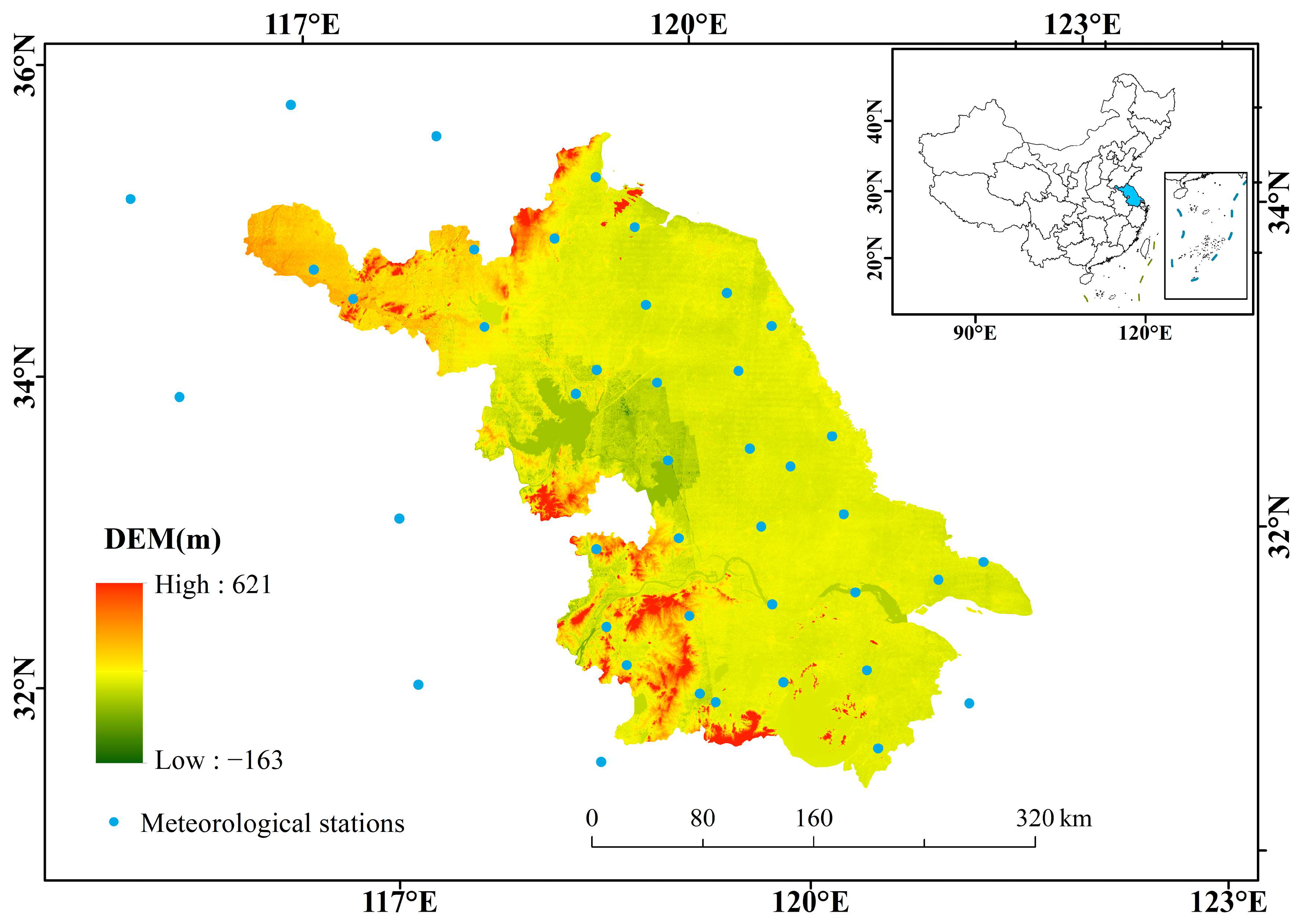
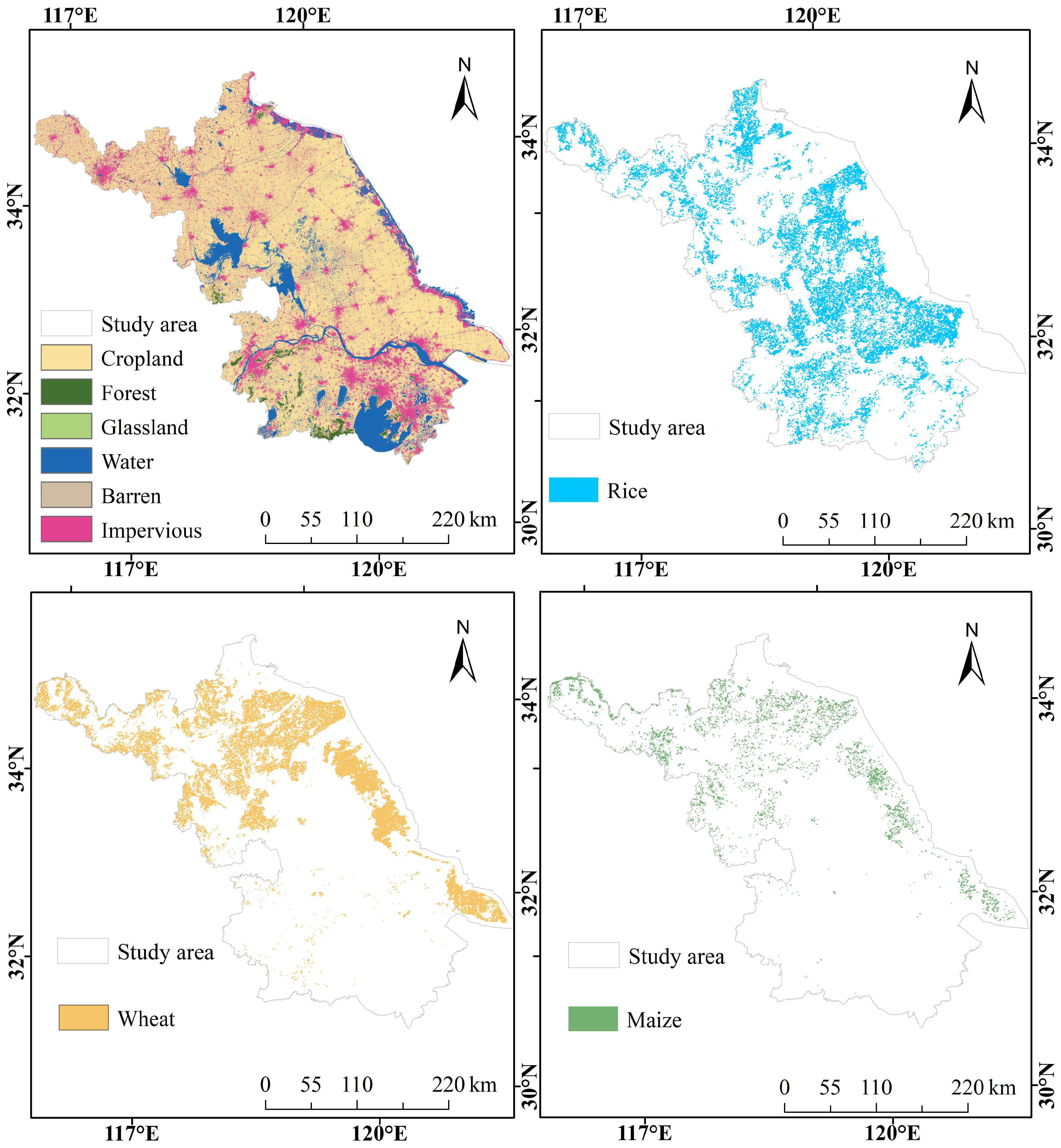
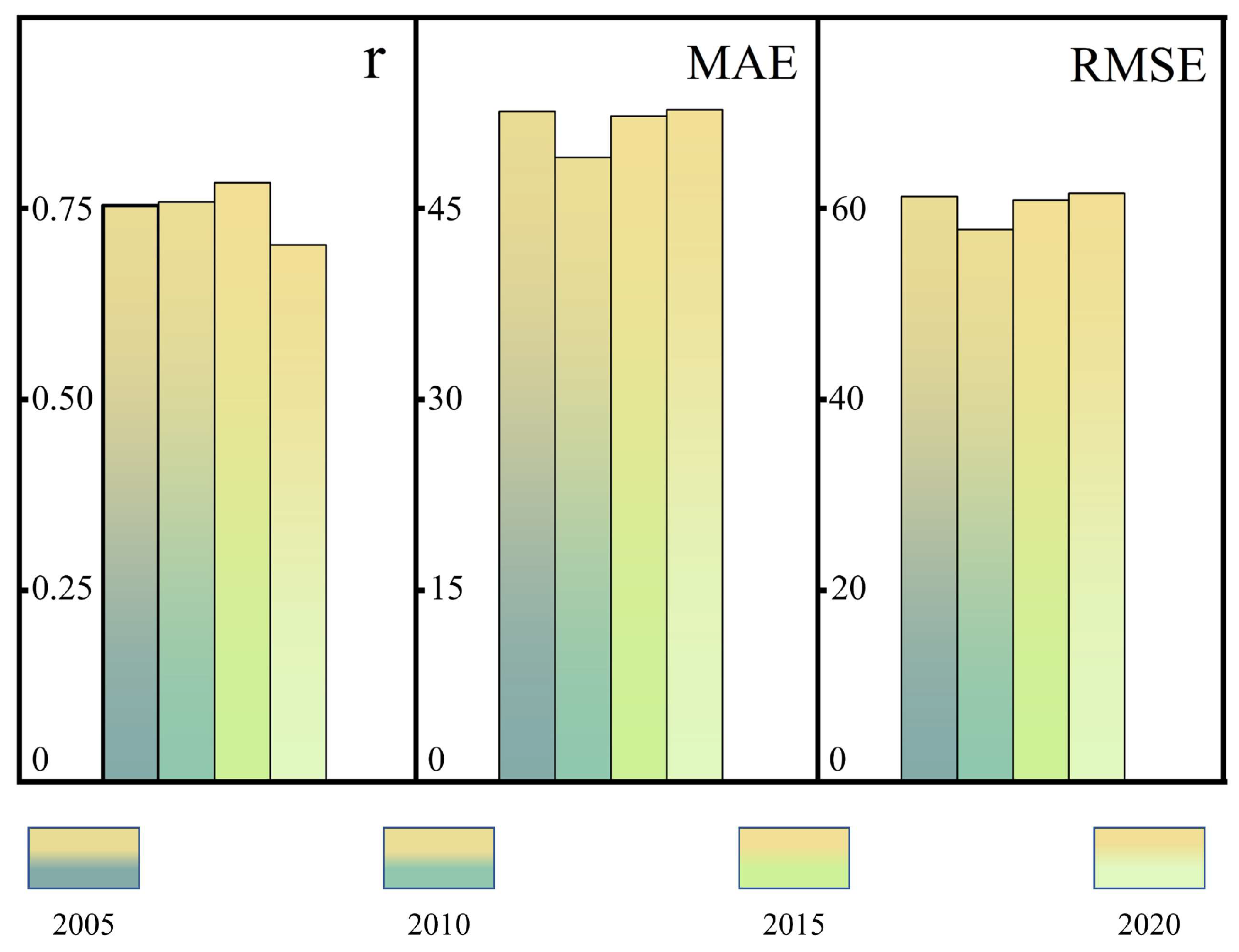
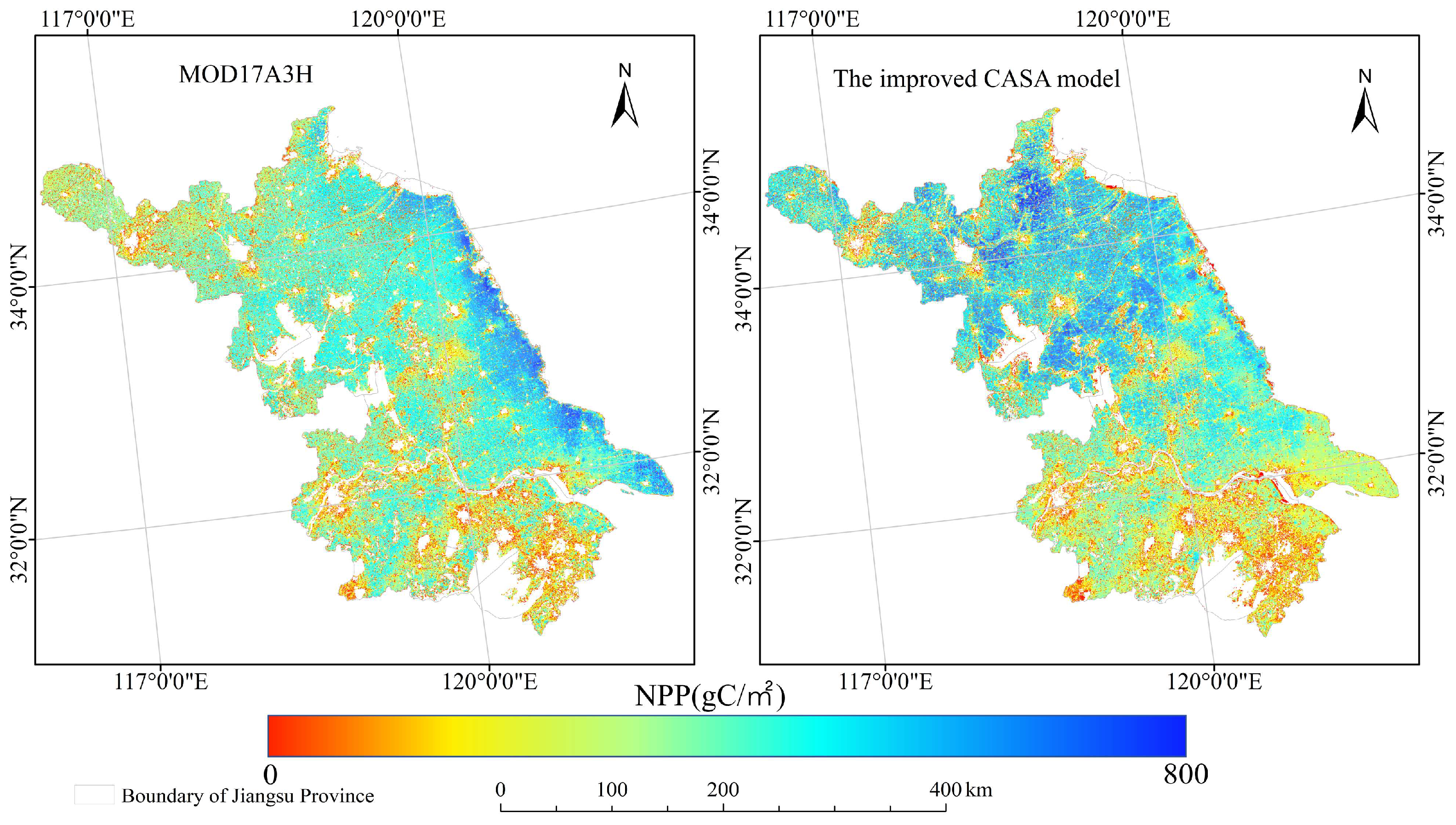
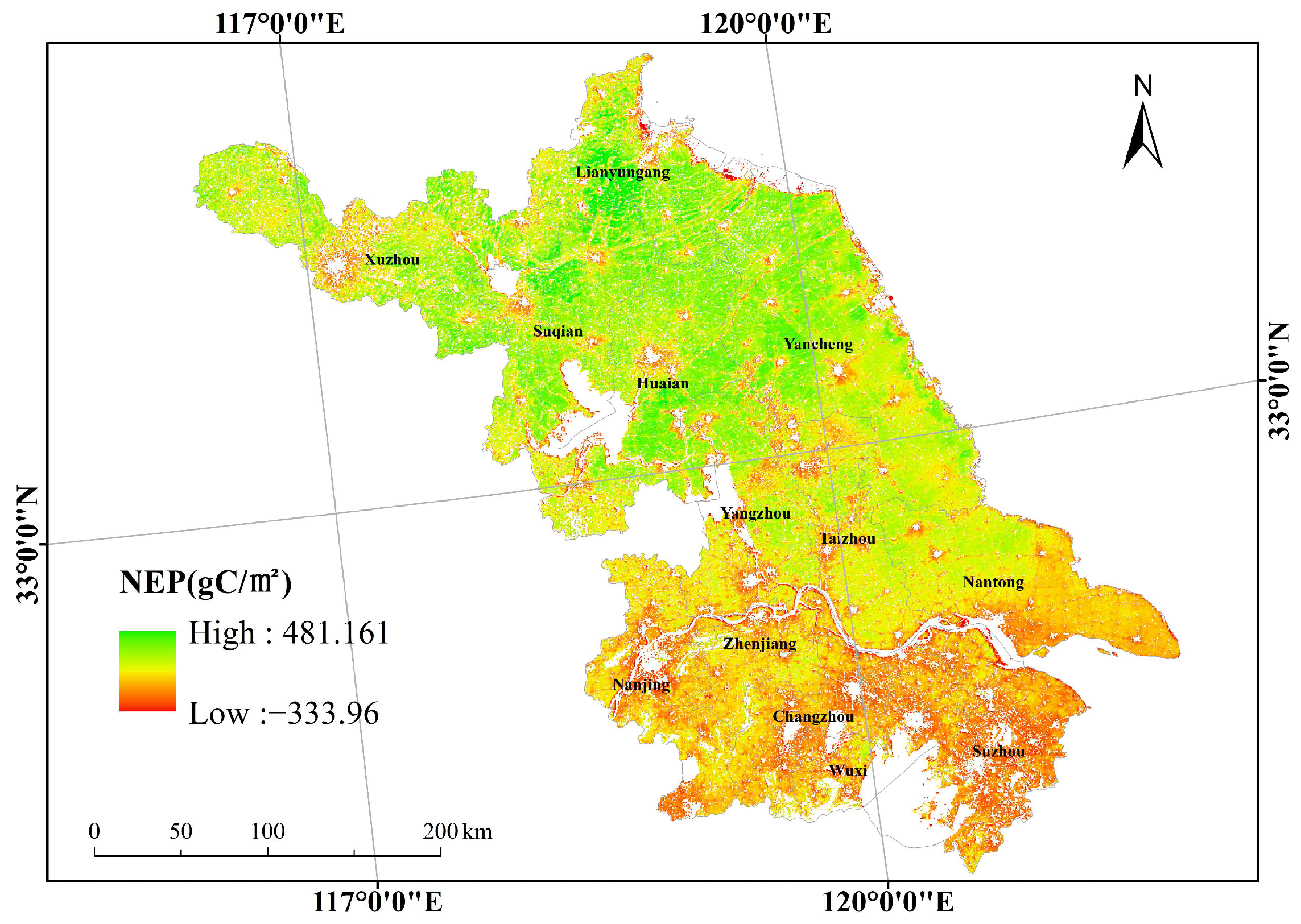
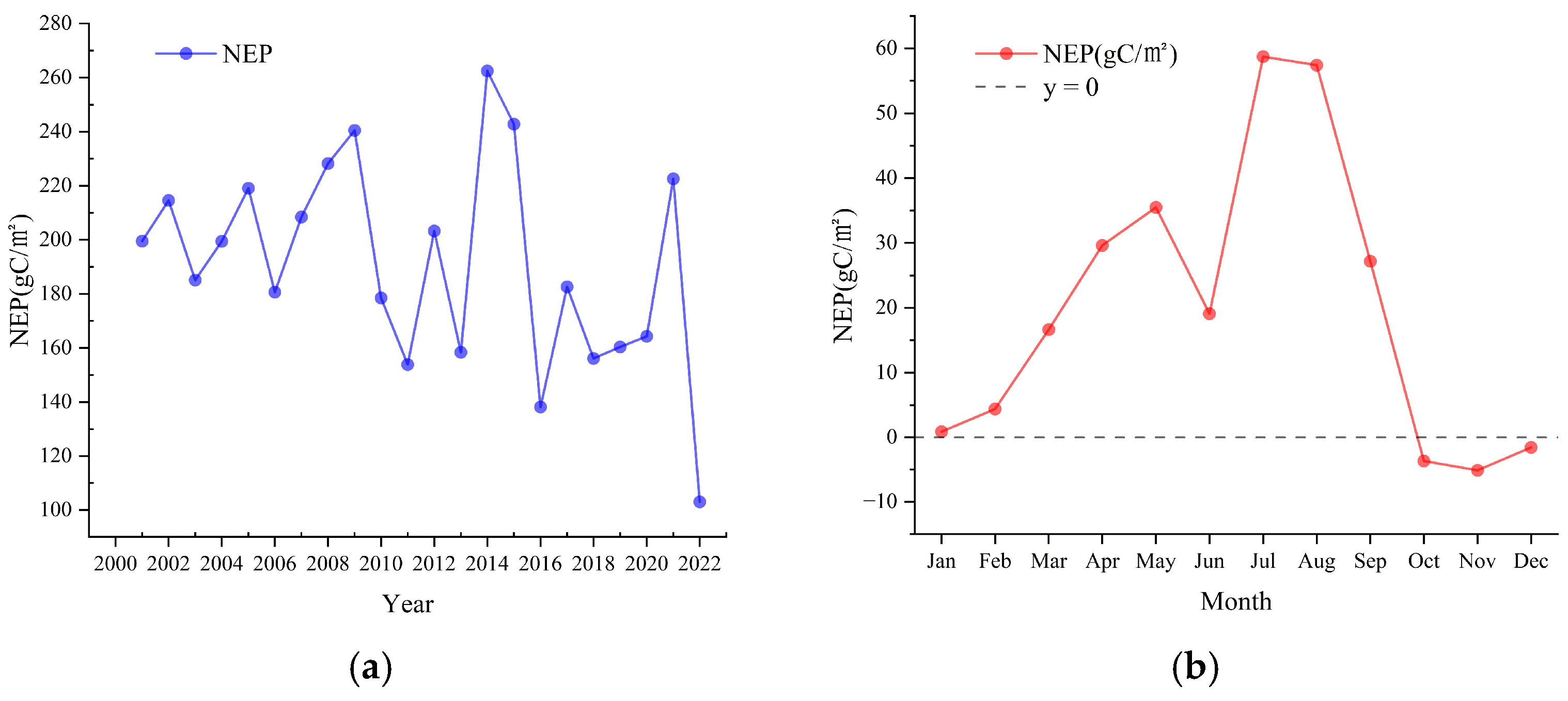


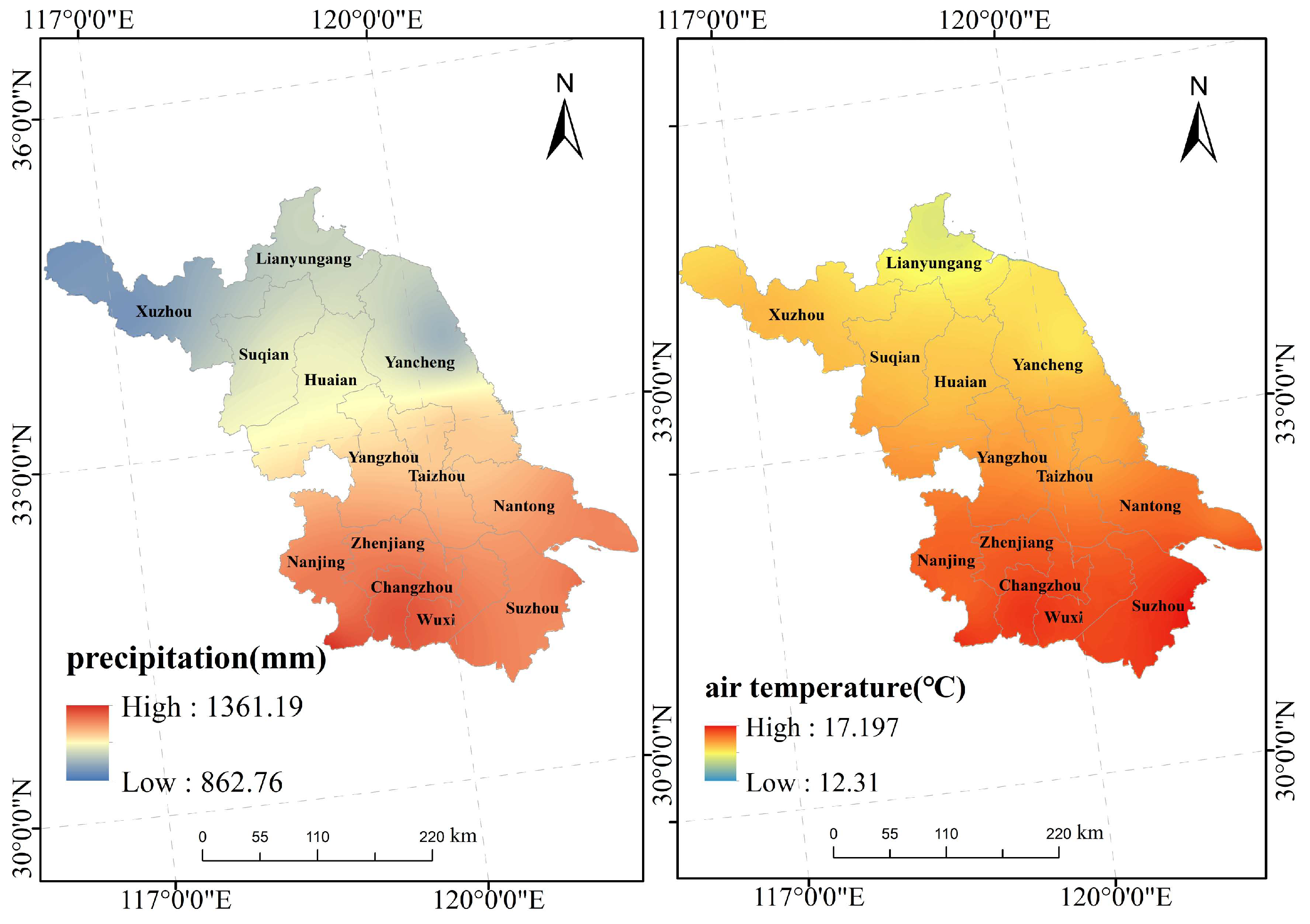


| Phenological Period | Wheat | Rice | Maize | Soybeans | Rape | ||
|---|---|---|---|---|---|---|---|
| Spring Maize | Summer Maize | Spring Soybeans | Summer Soybeans | ||||
| Seeding stage | Mid–late October to early November | Early–mid May | Late March to late April | Late May to early July | Late April to early May | Mid–late June | Late September to early October |
| Harvesting stage | Late May to mid–late June | October–early November | Late July to mid-August | Early September to late October | Late August to early September | October | May |
| Name | Code |
|---|---|
| Cropland | 1 |
| Forest | 2 |
| Shurb | 3 |
| Grassland | 4 |
| Water | 5 |
| Snow/Ice | 6 |
| Barren | 7 |
| Impervious | 8 |
| Wetland | 9 |
| β | Z | Trend Type | Trend Features |
|---|---|---|---|
| β > 0 | 2.58 < Z | 4 | Extremely significant increase |
| 1.96 < Z ≤ 2.58 | 3 | Significantly increased | |
| 1.65 < Z ≤ 1.96 | 2 | Micro-significantly increased | |
| Z ≤ 1.65 | 1 | Not significantly increased | |
| β = 0 | Z | 0 | No change |
| β < 0 | Z ≤ 1.65 | −1 | Not significantly reduced |
| 1.65 < Z ≤ 1.96 | −2 | Micro-significantly reduced | |
| 1.96 < Z ≤ 2.58 | −3 | Significantly reduced | |
| 2.58 < Z | −4 | Extremely significant reduced |
Disclaimer/Publisher’s Note: The statements, opinions and data contained in all publications are solely those of the individual author(s) and contributor(s) and not of MDPI and/or the editor(s). MDPI and/or the editor(s) disclaim responsibility for any injury to people or property resulting from any ideas, methods, instructions or products referred to in the content. |
© 2024 by the authors. Licensee MDPI, Basel, Switzerland. This article is an open access article distributed under the terms and conditions of the Creative Commons Attribution (CC BY) license (https://creativecommons.org/licenses/by/4.0/).
Share and Cite
Wang, P.; Xue, Y.; Yan, Z.; Yin, W.; He, B.; Li, P. Study of Regional Spatial and Temporal Changes of Net Ecosystem Productivity of Crops from Remotely Sensed Data. Land 2024, 13, 155. https://doi.org/10.3390/land13020155
Wang P, Xue Y, Yan Z, Yin W, He B, Li P. Study of Regional Spatial and Temporal Changes of Net Ecosystem Productivity of Crops from Remotely Sensed Data. Land. 2024; 13(2):155. https://doi.org/10.3390/land13020155
Chicago/Turabian StyleWang, Peng, Yong Xue, Zhigang Yan, Wenping Yin, Botao He, and Pei Li. 2024. "Study of Regional Spatial and Temporal Changes of Net Ecosystem Productivity of Crops from Remotely Sensed Data" Land 13, no. 2: 155. https://doi.org/10.3390/land13020155
APA StyleWang, P., Xue, Y., Yan, Z., Yin, W., He, B., & Li, P. (2024). Study of Regional Spatial and Temporal Changes of Net Ecosystem Productivity of Crops from Remotely Sensed Data. Land, 13(2), 155. https://doi.org/10.3390/land13020155







